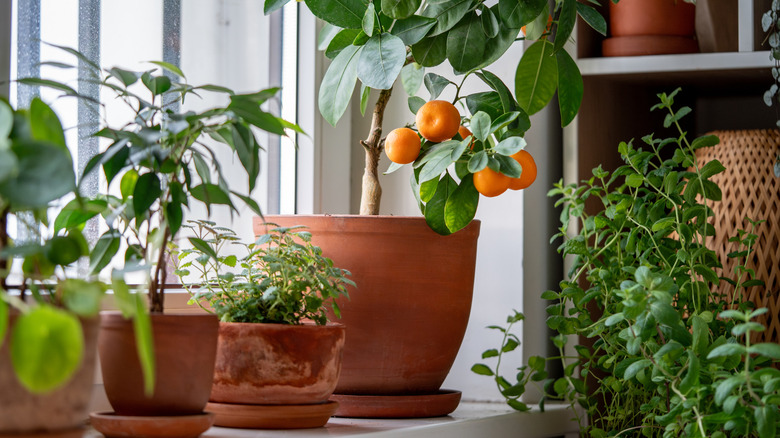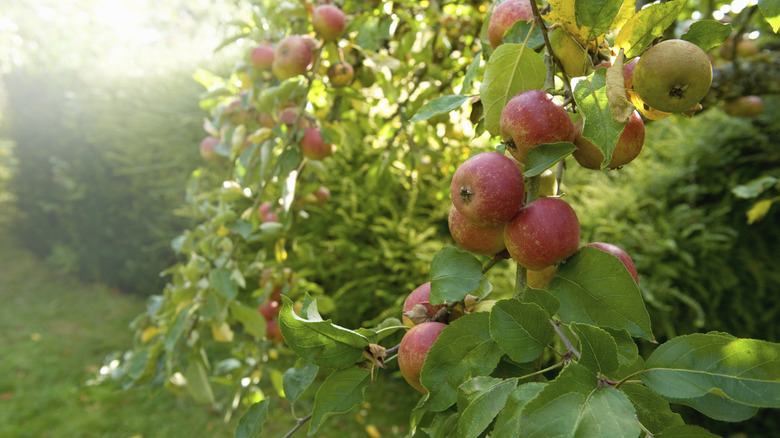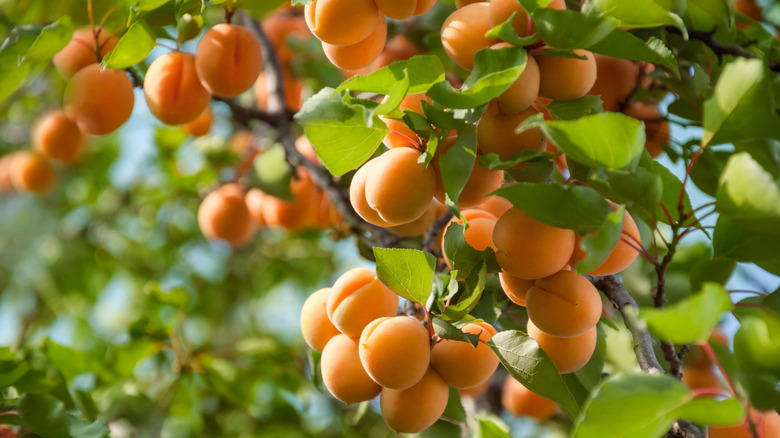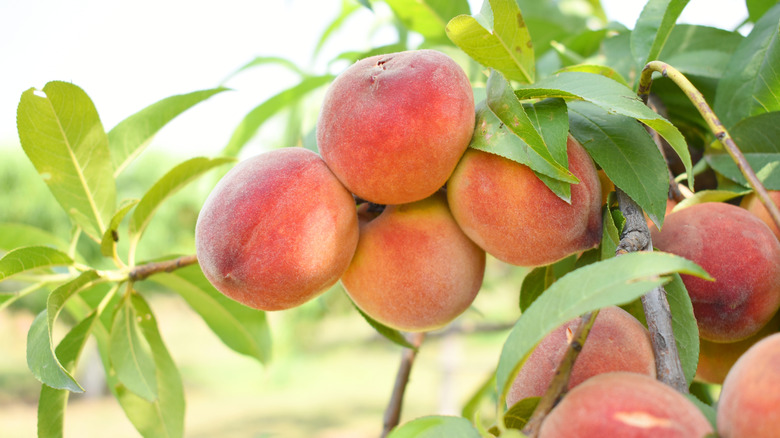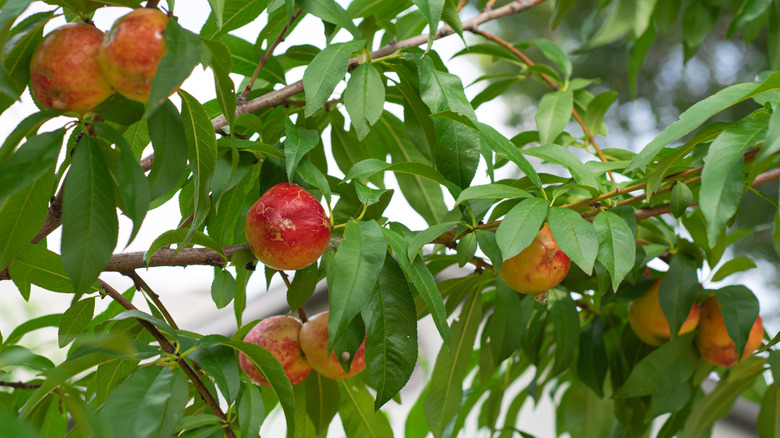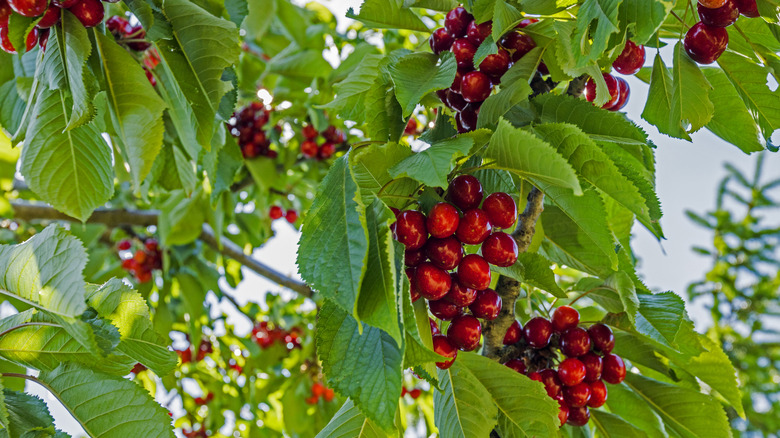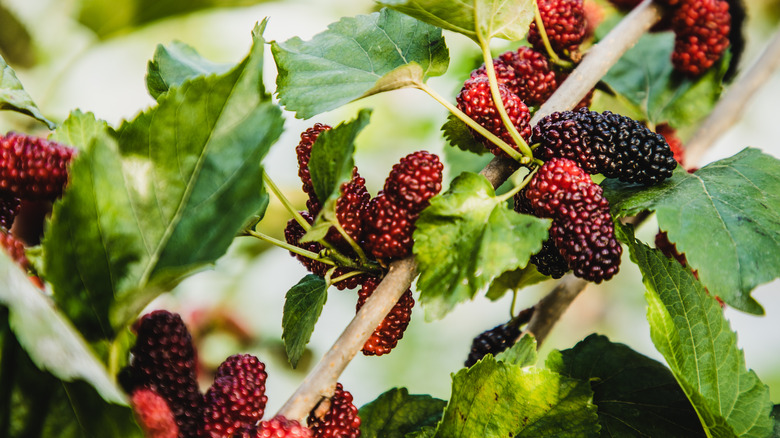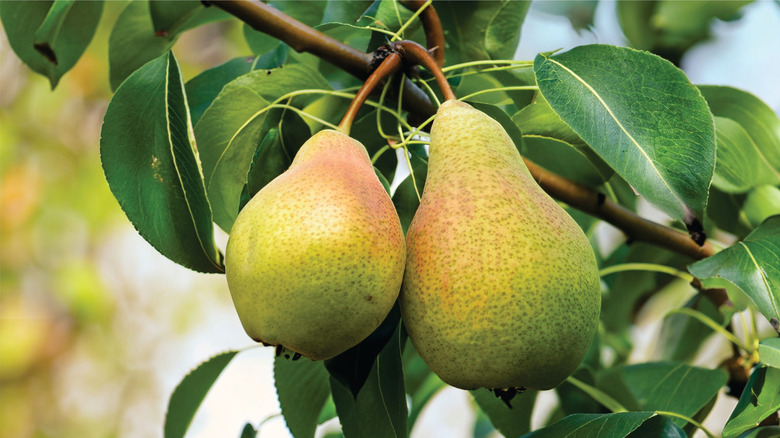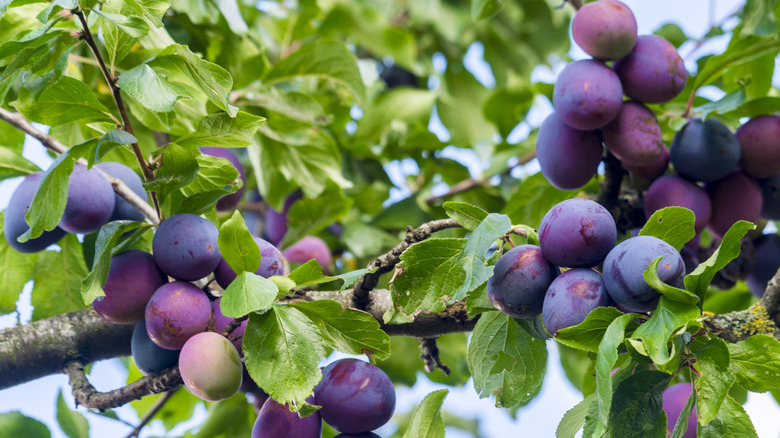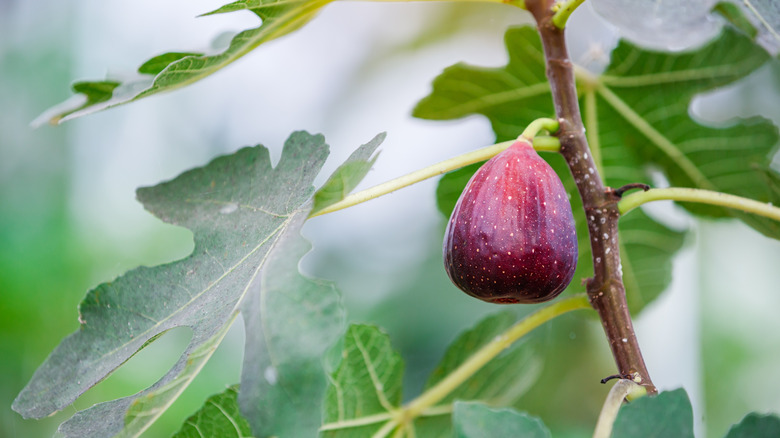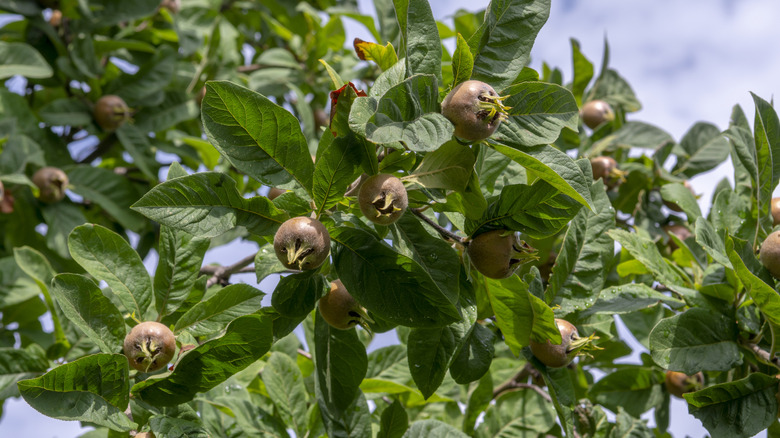10 Fruit Trees You Shouldn't Grow Indoors (& Some To Try Instead)
We may receive a commission on purchases made from links.
There's nothing quite like eating fruit fresh off of the branch. Unlike produce you'd purchase at grocery stores, home-grown fruit spends more time ripening on the tree, making it juicier and more flavorful. If you don't have space in your yard or want to try your hand at indoor gardening, you've perhaps considered caring for a few fruit trees inside your home. While there are several species you can grow indoors, some fruit trees are better left outside.
When choosing the best species to add to your home, you'll need to consider the care requirements first. Most fruit trees require a lot of sunlight to develop and bear fruit, so you can't place them in a low-light area (even seemingly bright windows might not fully meet their demands). Some have even more complicated needs, with temperate species requiring a cold dormancy period to grow properly and produce fruit. Additionally, you'll need to take into account the size of the tree, as many can reach dozens of feet tall and wide.
Picking the wrong fruit tree to try growing indoors could result in disappointment, wasted time and effort, and even the loss of the tree. To help you avoid this, we've rounded up the worst fruit trees to try indoors — and found some alternatives that have a higher chance of working. Some of these are easier-to-manage dwarfing or self-pollinating varieties. Others are entirely different fruit trees that are better suited to indoor conditions. Note: Even these more suitable types probably won't thrive without close attention, and, unless you have a large south-facing window, skylight, or sunroom, might need supplemental lighting.
Indoor conditions aren't at all ideal for apples
Heading to the apple orchard and picking fresh fruit from the tree is a cherished tradition for many, so it can be tempting to try and bring that experience to your home. Common apple trees (Malus pumila) are considered small fruit trees, but their 25-foot height and spread will seem a lot larger when it's growing in your living room. Native to Central Asia, this temperate species requires about 1,200 to 1,500 hours of temperatures below 45 degrees Fahrenheit (known as "chilling hours"), good air circulation, and plenty of sunlight, which can be challenging to accommodate indoors. Additionally, most apple trees need cross-pollination from another variety to produce fruit, making them even trickier to grow at home.
If you're determined to grow apples indoors, you'll need two varieties of dwarf apple trees for cross-pollination or a self-pollinating species, like the dwarf golden delicious (Malus domestica 'Golden Delicious'). Dwarf golden delicious is a self-fruiting variety that grows about 12 to 15 feet tall, though it will still require chilling hours. It's often said not to compare apples to oranges, but if you can't accommodate an apple tree's care requirements, you may want to consider an orange tree (Citrus sinensis), which is easier to acclimate to an indoor environment. Opt for a dwarf variety, like the Washington navel (Citrus × sinensis 'Washington'), which only grows to be 6 to 8 feet tall in pots. To keep your potted citrus trees thriving, make sure they get at least 8 hours of sunlight each day, so a position by a south-facing window is imperative, or even better, a sunroom.
Apricot trees are big and need a cold winter to set fruit
An avid baker knows the many uses apricots have in the kitchen, like being used in jams, glazes, or dessert fillings. An apricot (Prunus armeniaca) is not the easiest fruit tree to take care of, especially in your house. These are large trees, sometimes growing to a mature height of 40 feet, with a dense canopy that can be as wide as it is tall. Like apple trees, this species requires a chilly winter that transitions into a frost-free spring to flower. Additionally, this high-maintenance plant needs regular pruning to bear the best fruit.
If you're dead set on an apricot tree, you could attempt to grow a dwarf apricot tree (Prunus armeniaca 'Wilson Delicious') indoors. Standard 'Wilson Delicious' trees will grow up to 20 feet tall, so choose a variety with a grafted rootstock that limits its growth to 8 to 10 feet tall. This variety is self-pollinating, so you'll only need one of these trees to enjoy full-sized, delicious apricots. Although a smaller tree, it's still considered a high-maintenance plant that will require care and attention to bear quality fruit. Apricots are full sun lovers, so choose an area in your home that receives at least 8 to 10 hours of sunlight, though more is better. Consider purchasing a plant grow light, like LBW's Grow Light, to supplement sunlight and encourage a better fruiting season. Additionally, you'll need to move your pot outdoors during winter so your apricot tree has a cooling period.
Peach trees are picky about their growing conditions and prone to pests and disease
As the official fruit of Georgia, peaches have been a culinary staple for centuries, especially in the southern states. These fruits are readily available at most grocery stores, but what you may not know is how much work goes into growing them. Even in favorable conditions, peach trees (Prunus persica) are notoriously hard to grow, and even harder to provide conditions that lead to harvestable fruit. These trees like cold winters and hot summers. To successfully grow a peach tree, you'll need to fertilize regularly and prune carefully, and improper maintenance could lead to reduced fruit production and even cause their overall health to decline. Even with the best care, peach trees are prone to a multitude of pests and diseases that can be challenging to manage. Additionally, it's not recommended to keep full-size cultivars in pots, as you'll have to put them on a vigorous pruning schedule. Second-year wood is where the fruit production happens, and allowing new shoots to mature into their second year, while keeping the tree small, could be very tricky.
However, if you're a skilled gardener and want to take on the challenge, there are dwarf species you can try taking a risk on indoors. Peach 'Bonanza' (Prunus persica 'Bonanza') is a dwarf variety that grows well in pots, reaching about 6 feet tall. Like larger peach trees, they require adequate pruning, fertilization, and plenty of sunlight to thrive and bear fruit (making supplemental lighting a potential must). Keep in mind that even with supplemental light, your peach trees might still experience health issues, given how susceptible they are to disease, and you may need to implement a spraying program and regularly inspect your tree. Here's how to spot the most common fruit tree diseases (including those specific to peaches) so you can tackle them before they become a serious problem.
Nectarine trees can be as hard to care for as peaches, and their cultural requirements make them a bad candidate for indoors
Peaches and nectarines are so closely related that the only genetic difference is the fuzz found on peaches. Similar to their furrier cousin, nectarine trees (Prunus persica var. nucipersica) can be as difficult, if not more challenging, to grow than peach trees. Peach trees aren't especially cold hardy themselves, but nectarine trees are even more sensitive to frost. However, like other temperate fruits, nectarines also require a chilly winter to jumpstart fruit production in spring. To have a successful nectarine harvest, you need to provide the proper climate requirements (plenty of direct sun, protection from winds, the right ranges of temperatures) and cater to their pruning needs. Unfortunately, even if you meet their care requirements, nectarine trees are also highly susceptible to pests and diseases.
If you don't mind putting in extra effort and really want to attempt cultivating some nectarines indoors, you can find dwarf varieties that grow well in containers. Dwarf nectarine (Prunus persica var. nectarina 'Leprechaun') is a smaller variety that becomes between 4½ and 5½ feet tall and may be a potential option. To give it the best chance of surviving (and hopefully producing some fruit), you'll need to stay on top of watering regularly, fertilizing throughout the growing season, and pruning properly. Check your plant's leaves, stems, and fruits for signs of pests like mites or aphids, as well as any growth changes or discoloration that could be caused by disease. Nectarines require full sun and should never be shaded, therefore, this is another stone fruit that might need supplemental lighting if grown indoors.
Cherry trees have significant chill requirements and probably won't be happy inside
Between their delicious fruit and beautiful blooms in spring, there's a lot to love about cherry trees (Prunus avium). Unfortunately, like other stone fruits, these pretty plants typically don't fare well indoors. As another temperate tree species, they require a specific yearly climate with mild summers and chilly winters to bear fruit. The number of required chill hours for cherry trees depends on the species, though most have high chilling requirements, typically ranging between 700 to over 1,000 hours. Additionally, most cherry trees are self-unfruitful, so you'd need two different varieties for pollination.
If you love cherry trees for their pretty flowers as much as their fruit, a Meyer lemon tree (Citrus x limon 'Meyer') may be the perfect alternative. Because these trees only reach 6 to 10 feet tall, you can easily grow a lemon tree indoors. While cherry trees require ample sunlight, lemon trees can grow in partial shade, though their best fruiting and flowering occurs when situated in full sun. Although Meyer lemon trees struggle with self-pollination when grown inside the house, you can set them outside to let wind and pollinators do the job, or hand pollinate the tree. To do so, use a Q-tip to gently rub the center of the flower, then use the same end of the cotton swab to rub the pollen onto the center of surrounding flowers. You can also try giving the branches a gentle shake every so often. With proper care, you can enjoy white blooms and fresh lemons at intervals throughout the year.
Mulberry trees are too large and messy for most spaces
Mulberries may make a healthy snack if you can get your hands on them, but they're not the best tree to grow indoors. The most common species, red mulberry (Morus rubra), typically grows to between 35 and 50 feet, sometimes reaching up to 80 feet tall. Although you can find smaller species, like the dwarf mulberry (Morus rubra 'Super Dwarf'), you probably wouldn't want to grow it inside your home. Mulberry trees are notorious for being messy, with their fruits falling off the tree and causing staining on sidewalks and driveways. If you kept the plant indoors, there's a good chance you'd end up with a red-spotted floor. Their fruit also has an extremely short shelf life, with berries only being good to eat within a couple of days after picking them.
If you want a sweet fruit with a touch of tart to grow indoors, dwarf pomegranate (unica granatum var. nana) is worth considering. It's a showy tree filled with reddish-orange flowers in summer that's considered low maintenance. They can grow in partial shade, though full sun is better for bearing fruit. Once established, they're relatively drought-tolerant and need even less watering in the winter.
You'll have problems trying to get pear trees to bear indoors
Pears are a delicious fruit high in antioxidants, fiber, minerals, and nutrients, but should you grow a pear tree (Pyrus communis) in your house? Unfortunately, pears are another deciduous tree that needs chilling hours if you wish to harvest any fruit. Additionally, they aren't self-pollinating, so you'd need to grow two varieties indoors and hand-pollinate them. Even if you were able to successfully pollinate the tree, it can sometimes take up to a decade before your pear tree produces fruit. Although semi-dwarf pear trees exist, they're a bit more challenging to find.
If you're looking for a slightly less tricky tree to try, dwarf guava trees (Psidium guajava 'Nana') could be an option to experiment with. While it may not bear the same fruit, many describe the flavor of guava as a cross between a pear and a strawberry. One major benefit is it's a tropical fruit tree you can harvest all year round in warm climates. If you can replicate these natural conditions indoors, you may be rewarded with a relatively healthy, compact tree in a container that might even yield fruit. To keep your dwarf guava happy, make sure it has plenty of direct sunlight (or supplemental lighting), regular watering, and fertilization during the growing season. Once your home is filled with a sweet aroma, you'll know it's time to harvest your fruit.
Plums are another bad pick, as they grow too large, need some cold, and don't self-pollinate
There's no doubt that a plum tree (Prunus domestica) in bloom is a breathtaking sight, with dainty white blossoms covering each of the stems. Although plum trees are relatively small fruit trees, they can still reach up to 20 feet tall, which would hit the ceiling in most households. And while some species are partially self-fertile, it's generally recommended to have two varieties if you want a bigger harvest. As temperate trees, they'll need a long, cold winter before they'll be ready to give you any fruit.
However, if you live in a northern region and don't mind transporting your plant outside for its winter nap, you can test drive growing a dwarf Stanley European plum tree (Prunus domestica 'Stanley') indoors. It reaches 8 to 10 feet tall and wide at maturity, and produces blue, medium-sized fruit. However, you'll get a more consistent harvest if you grow an additional plum tree variety and hand-pollinate. It requires at least six hours of direct sunlight, so make sure you place it in front of a sunny window for optimal growth or give it supplemental lighting. It can be somewhat high maintenance in regards to training and pruning, but the extra work could be worth the effort.
Fig trees can get large, need lots of light to fruit well, and like a little cold
Fig trees (Ficus carica) are popular for their ornamental value and sweet, edible fruit. For the most delicious harvest, figs will need 6 to 8 hours of direct sunlight each day, which isn't always possible for houseplants. As they mature, they can grow to be 20 feet tall with a similar spread and tend to be messy when they shed their leaves. Although not as extreme as some other fruit trees, figs still require between 100 and 200 hours of temperatures below 45 degrees Fahrenheit during dormancy.
Of course, if you're keen for a challenge there's no harm in experimenting with indoor fig growing. As a safeguard, try taking some cuttings (which is the easiest way to propagate a fig tree) beforehand. Should your fig die during the indoor experiment, you'll at least have a backup plant to go on with. Unless you have a skylight or large window that gets sun all day, consider giving your fig supplemental lighting. Also, definitely go with a dwarf variety, and prune to retain just a few main fruiting branches. The 'Little Miss Figgy' dwarf fig (Ficus carica 'MAJOAM') is an edible fig tree that stops growing once it reaches about 4 feet tall. It has medium water needs — which generally means you just water when the topsoil is dry — and giving it too many showers in fall is a watering mistake that could kill your precious fig tree. Once the cold season hits, put the watering can away. During this time, you can try relocating your fig to the garage or basement for some cold exposure — but if the temperature doesn't dip below 45 degrees Fahrenheit in these areas, instead, place your figs outdoors so they are exposed to 100-200 hours of cold (during a time when temps don't go too far below 30 degrees).
Medlar trees grow tall and need a few hundred chill hours
Although medlar trees (Mespilus germanica) are one of the best winter plants to decorate your patio with for a gorgeous pop of color, they may not be the best for growing indoors. Even if your tree is only a few feet tall when you purchase it, it'll reach up to 20 feet high with a similar spread at maturity. As the growing season comes to an end, your medlar tree will shed its leaves and get ready for winter dormancy, where it'll need a few hundred hours of cold temperatures.
Rather than cleaning up a mess of leaves and worrying about taking your plant outside for winter, try growing a different ornamental fruit tree, like the Nagami kumquat (Fortunella margarita). Kumquats are one of the easiest trees to grow as houseplants and can thrive indoors in proper conditions. This hardy tree grows well in containers and is relatively low-maintenance. You'll only need to prune to remove dead limbs or to manage its growth and shape. Place your kumquat plant in a room with a lot of sunlight and water it when the soil begins to dry out, and it should reward you with juicy, delicious fruit.
